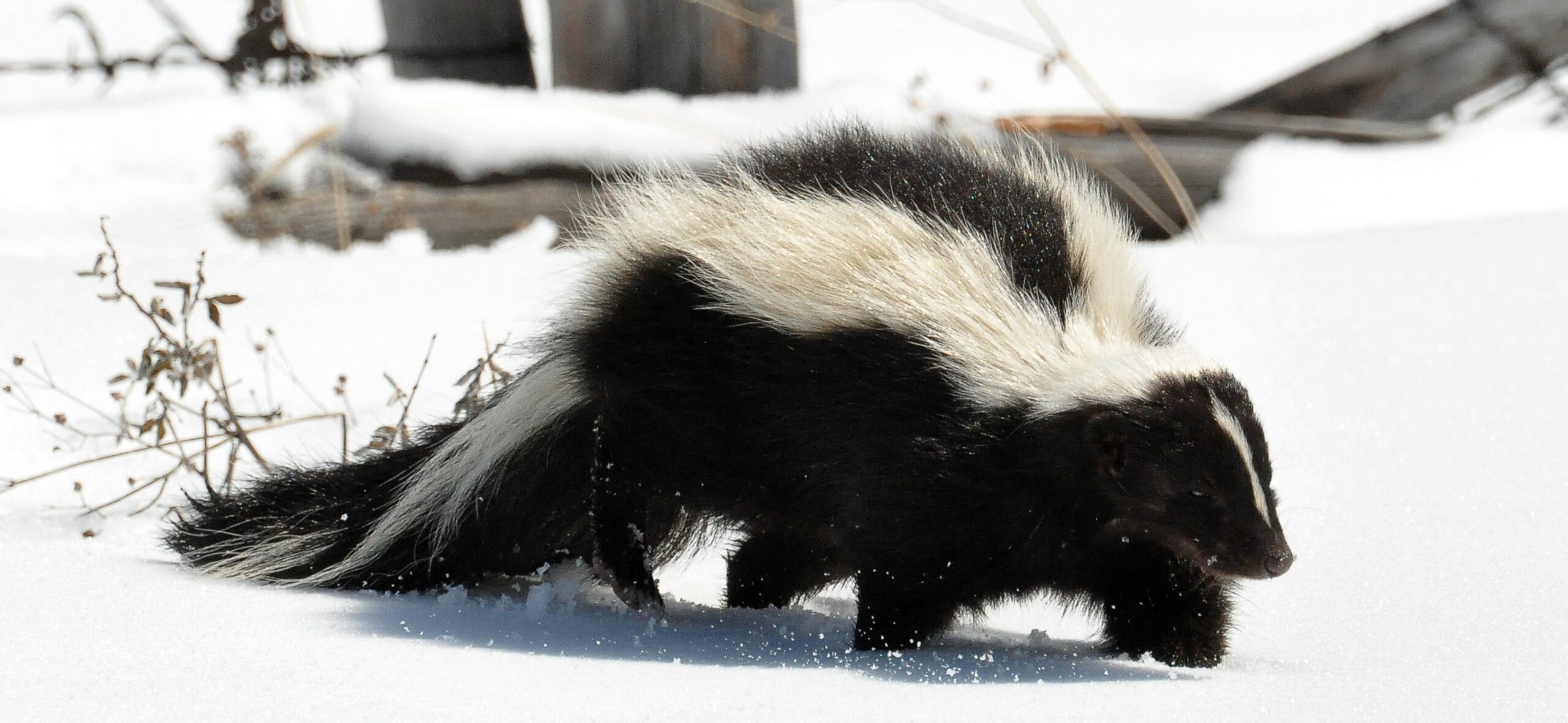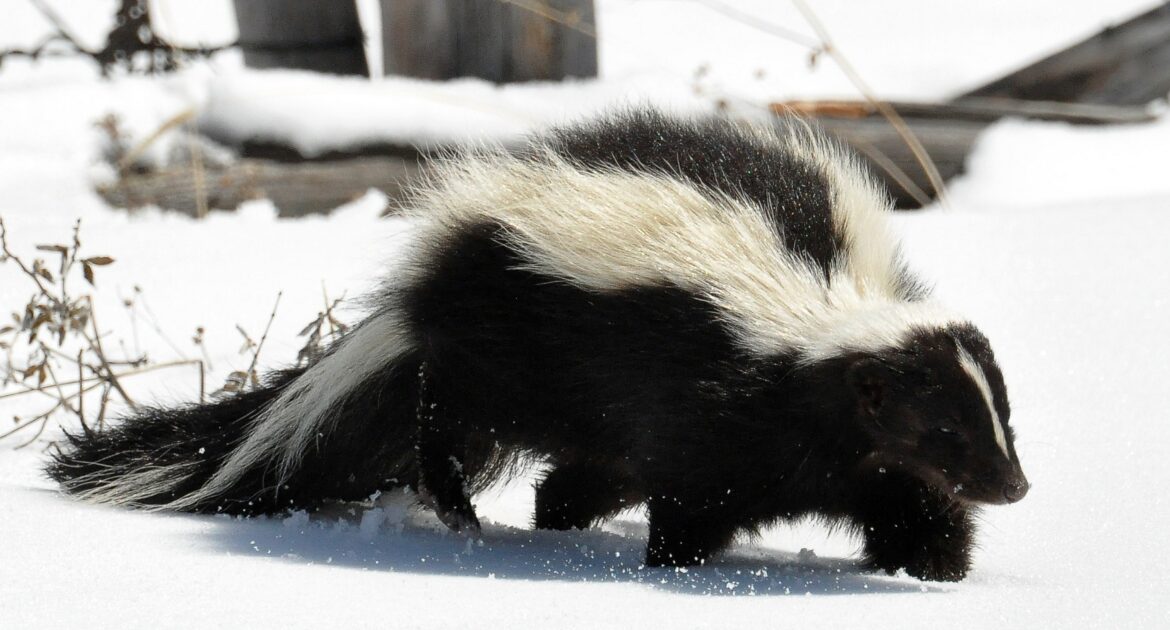You might think skunks disappear when autumn arrives, but these clever black and white striped animals are actually busier than ever. As the leaves change colour and temperatures drop across Canada, skunk behaviour in autumn becomes fascinating to watch. These remarkable animals have developed smart strategies to survive our harsh winters, and understanding how skunks prepare for winter can help you better protect your property.
Autumn skunk habits centre around one main goal: getting ready for the coldest months ahead. Unlike bears that hibernate completely, skunks enter a lighter sleep called torpor during winter. This means they need to work extra hard in the fall to store enough energy and find the perfect shelter.
You’ll notice increased skunk activity around your home during these months as they search for food and safe places to wait out winter.
In this guide, we’ll explore the remarkable ways skunks prepare for cooler weather. You’ll learn about their eating habits, shelter-seeking behaviour, and why autumn is such a critical time for these animals.
We’ll also discuss what this means for homeowners and how professional wildlife control services can help manage any issues that arise.
Building Winter Fat Reserves
Skunks become eating machines during the autumn months. Just like you might stock your pantry before a big storm, skunks must build up fat reserves to survive winter’s challenges. This process, called hyperphagia, drives them to consume nearly twice their normal food intake.
During September and October, you might notice more skunks active in your neighbourhood. They’re working around the clock to find:
- Grubs and beetle larvae hiding in your lawn
- Fallen fruits from trees and gardens
- Small rodents and insects
- Bird eggs when available
- Pet food left outside
A healthy adult skunk can gain up to 30% of their body weight during this preparation period. This extra fat acts like a built-in heating system and food source during the coldest months when hunting becomes nearly impossible.
Skunks have excellent memories for food sources. If they found success in your yard last autumn, they’ll likely return this year. Their keen sense of smell can detect grubs up to three inches underground, making well-maintained lawns particularly attractive during fall months.
Finding the Perfect Winter Den
How skunks prepare for winter involves more than just eating. Finding a suitable shelter becomes their second most important task. Skunks don’t build elaborate homes like some animals. Instead, they look for existing spaces that offer protection from wind, snow, and predators.
Popular skunk den locations include:
- Spaces under decks and porches
- Hollow logs or tree roots
- Abandoned burrows from other animals
- Areas beneath sheds or garages
- Crawl spaces under homes
Skunks prefer dens with multiple escape routes when possible. They’re naturally cautious animals and want options if danger appears. The ideal den stays above freezing, remains dry, and provides enough space for the skunk to turn around comfortably.
Female skunks often share winter dens with their grown kits or other females. This behaviour, called communal denning, helps them stay warmer by sharing body heat. Male skunks typically prefer solitary winter homes but may occasionally share space during extremely cold spells.
Preparing Their Chosen Den Site
Once skunks select their winter headquarters, they become busy decorators. Skunk behaviour in autumn includes gathering insulation materials to make their dens as cozy as possible. You might notice leaves, grass, and other soft materials disappearing from your yard during this time.
Skunks line their dens with:
- Dried leaves and grass
- Pine needles where available
- Strips of bark
- Any soft materials they can find
They often create a plug at the den entrance using these same materials. This natural door helps keep cold air out and warm air in during the depths of winter. The plug also provides camouflage from potential predators who might be searching for an easy meal.
Smart skunks will test their dens before winter arrives in earnest. They’ll spend a few nights sleeping in their chosen spot to make sure it stays dry and comfortable. If problems arise, they’ll search for better options while temperatures remain mild.
Changes in Daily Routines
Autumn brings noticeable shifts in autumn skunk habits. Skunks naturally become more active during the cooler parts of the day. You’ll often see them during early morning hours or late afternoon when temperatures drop, but visibility remains good.
Their foraging patterns change significantly during fall months. Instead of casual hunting throughout their territory, skunks focus intensive efforts on the most productive food sources. They’ll spend hours working a single grub-rich lawn rather than wandering widely like they do in summer.
Skunks also become less social during autumn preparation time. While they might have shared feeding areas peacefully during summer, competition for the best food sources intensifies as winter approaches. Each skunk focuses on building their personal energy reserves.
Timing Is Everything
The timing of skunk winter preparations depends largely on local climate conditions. In warmer regions of Canada, skunks might continue active preparation into November. In colder areas, they begin serious winter prep as early as August.
Weather patterns influence their behaviour significantly. Warm autumn days encourage continued foraging and den preparation activities. Cold snaps or early snowfall can trigger skunks to enter their winter dens earlier than usual.
You can predict increased skunk activity by watching local weather forecasts. Expect to see more skunks during the warm days before major cold fronts arrive. They instinctively know when conditions will change and rush to complete final preparations.
Physical Changes for Winter Survival
Skunks undergo remarkable physical changes during autumn months. Their fur grows thicker and develops better insulating properties. The dense undercoat that emerges helps trap warm air close to their skin during cold weather.
Their metabolism also adjusts in preparation for winter’s challenges. As daylight hours decrease, hormonal changes signal their bodies to slow down and conserve energy. This natural process helps them survive on stored fat reserves when food becomes scarce.
Even their spray production changes during fall. While skunks can spray year-round, they become more selective about using this energy-expensive defence mechanism as winter approaches. They save their spray for truly serious threats rather than minor annoyances.
What This Means for Homeowners
Understanding how skunks prepare for winter helps you protect your property during these active autumn months. Increased skunk activity around your home during fall is completely normal behaviour. They’re simply following ancient instincts to survive the coming cold.
However, you don’t want skunks settling under your deck or porch for the winter. Once established, they’re unlikely to leave voluntarily until spring arrives. Professional wildlife control becomes essential if skunks choose your property for their winter headquarters.
Signs that skunks are preparing winter dens on your property include:
- Fresh digging around foundations or structures
- Strong skunk odours that persist for days
- Disturbed insulation materials or outdoor cushions
- Small holes in lawns where they’ve searched for grubs
Professional Wildlife Control Solutions
If skunks have selected your property for winter preparation, professional help provides the most effective and humane solution. Skedaddle Humane Wildlife Control specializes in managing these situations without harm to the animals or your family.
Our one-way doors represent the gold standard in humane wildlife control. These specially designed devices allow skunks to exit their chosen den site but prevent re-entry. The animals can leave safely when they’re ready, but cannot return to cause further problems.
Professional wildlife control offers several advantages over attempting DIY solutions:
- Guaranteed humane treatment of animals
- Proper identification of all entry points
- Long-term prevention strategies
- Safe handling by experienced technicians
- Legal compliance with wildlife protection regulations
Ready to Solve Your Skunk Concerns?
Skunk behaviour in autumn represents one of nature’s most impressive survival strategies. While we can admire their preparation skills, we don’t want them establishing winter headquarters under our homes. Understanding how skunks prepare for winter helps you recognize the signs and take appropriate action.
Professional wildlife control provides peace of mind during these challenging autumn months. Autumn skunk habits that seem problematic today can become major headaches once winter weather traps these animals under your property.
Skedaddle Humane Wildlife Control in London offers expert solutions tailored to your specific situation. Our experienced team understands local skunk behaviour patterns and provides effective, humane removal services. Don’t let autumn skunk preparation turn into a winter-long problem under your home.
Request an estimate today to learn how our professional wildlife control services can protect your property while respecting these remarkable animals. Contact Skedaddle and discover why homeowners across the region trust our expertise for all their wildlife control needs.




